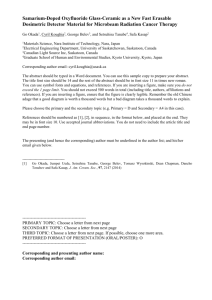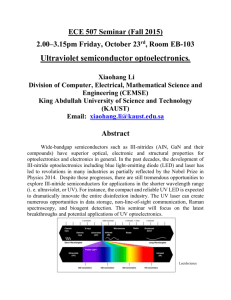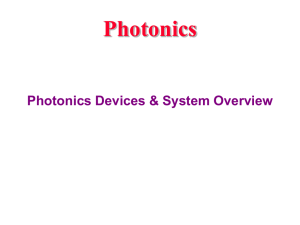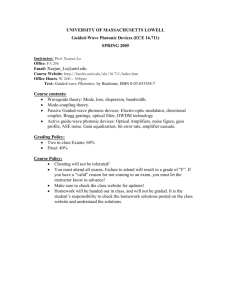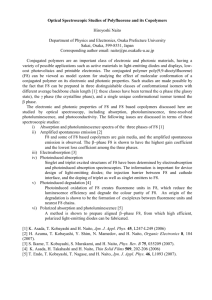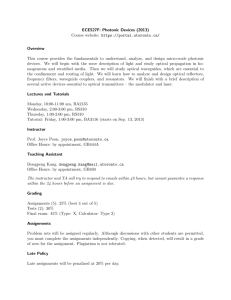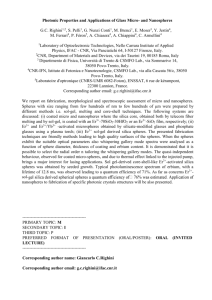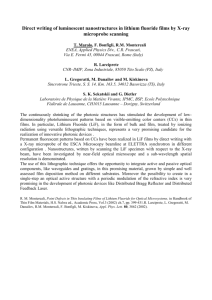Abstract - icoopma 2008
advertisement
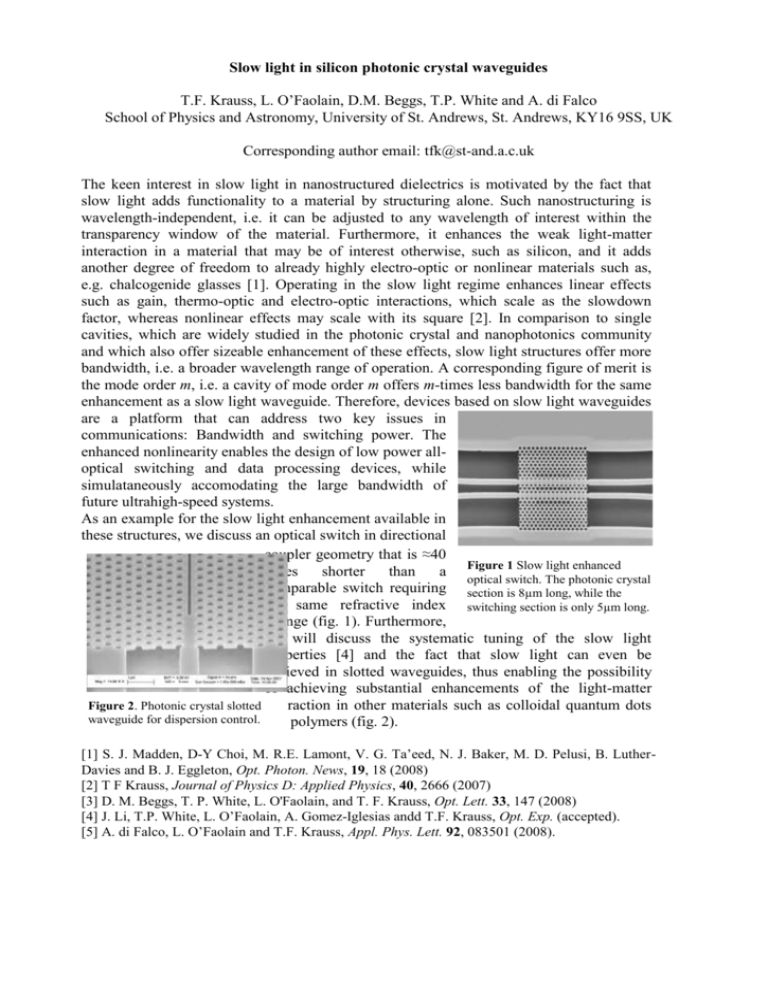
Slow light in silicon photonic crystal waveguides T.F. Krauss, L. O’Faolain, D.M. Beggs, T.P. White and A. di Falco School of Physics and Astronomy, University of St. Andrews, St. Andrews, KY16 9SS, UK Corresponding author email: tfk@st-and.a.c.uk The keen interest in slow light in nanostructured dielectrics is motivated by the fact that slow light adds functionality to a material by structuring alone. Such nanostructuring is wavelength-independent, i.e. it can be adjusted to any wavelength of interest within the transparency window of the material. Furthermore, it enhances the weak light-matter interaction in a material that may be of interest otherwise, such as silicon, and it adds another degree of freedom to already highly electro-optic or nonlinear materials such as, e.g. chalcogenide glasses [1]. Operating in the slow light regime enhances linear effects such as gain, thermo-optic and electro-optic interactions, which scale as the slowdown factor, whereas nonlinear effects may scale with its square [2]. In comparison to single cavities, which are widely studied in the photonic crystal and nanophotonics community and which also offer sizeable enhancement of these effects, slow light structures offer more bandwidth, i.e. a broader wavelength range of operation. A corresponding figure of merit is the mode order m, i.e. a cavity of mode order m offers m-times less bandwidth for the same enhancement as a slow light waveguide. Therefore, devices based on slow light waveguides are a platform that can address two key issues in communications: Bandwidth and switching power. The enhanced nonlinearity enables the design of low power alloptical switching and data processing devices, while simulataneously accomodating the large bandwidth of future ultrahigh-speed systems. As an example for the slow light enhancement available in these structures, we discuss an optical switch in directional coupler geometry that is ≈40 times shorter than a Figure 1 Slow light enhanced optical switch. The photonic crystal comparable switch requiring section is 8µm long, while the the same refractive index switching section is only 5µm long. change (fig. 1). Furthermore, we will discuss the systematic tuning of the slow light properties [4] and the fact that slow light can even be achieved in slotted waveguides, thus enabling the possibility of achieving substantial enhancements of the light-matter Figure 2. Photonic crystal slotted interaction in other materials such as colloidal quantum dots waveguide for dispersion control. and polymers (fig. 2). [1] S. J. Madden, D-Y Choi, M. R.E. Lamont, V. G. Ta’eed, N. J. Baker, M. D. Pelusi, B. LutherDavies and B. J. Eggleton, Opt. Photon. News, 19, 18 (2008) [2] T F Krauss, Journal of Physics D: Applied Physics, 40, 2666 (2007) [3] D. M. Beggs, T. P. White, L. O'Faolain, and T. F. Krauss, Opt. Lett. 33, 147 (2008) [4] J. Li, T.P. White, L. O’Faolain, A. Gomez-Iglesias andd T.F. Krauss, Opt. Exp. (accepted). [5] A. di Falco, L. O’Faolain and T.F. Krauss, Appl. Phys. Lett. 92, 083501 (2008). --------------------------------------------PRIMARY TOPIC: Q SECONDARY TOPIC: P THIRD TOPIC: M PREFERRED FORMAT OF PRESENTATION (ORAL/POSTER): Invited --------------------------------------------Corresponding author name: Thomas F Krauss Corresponding author email: tfk@st-and.ac.uk Please name this file: LastName_Topic1_Topic2 TOPICS Please choose primary and secondary topics A B C D E F G H I J K L M N O P Q R S T U V W X Optical properties of materials A1 General A2 Crystals A3 Polycrystalline bulk and film A4 Amorphous and organics A5 Nanostructures, including photonic crystals Preparation and Characterization of Quantum Dots, Quantum Wires and Other Quantum Structures Excitonic Processes Luminescence, Phosphors, Scintillators and Applications Photoinduced Effects and Applications Photoconductivity and Photogeneration Nonlinear Optical Effects and Applications Electro-Optic Effects and Applications Glasses for Optics, Optoelectronics and Photonics (including ZBLAN, fluozirconate, oxyfluoride and other glasses) Polymers for Optics, Optoelectronics and Photonics Semiconductors for Optoelectronics J1 Semiconductors for Optoelectronics: Wide Bandgap J2 Semiconductors for Optoelectronics: Narrow Bandgap J3 Semiconductors for Optoelectronics: Heterostructures Light Emitting Devices (including organics) Photonic and Optoelectronic Materials and Devices (including devices for telecommunications, laser and detectors) Optical Storage Photovoltaics (materials and devices, and their properties) Waveguides and Integrated Photonics Silicon Photonics Optical Fibers and Fiber Sensors Experimental Techniques Femtosecond Spectroscopy Teraherz (THz) techniques, including materials, emitters and detectors Defect Spectroscopy Plasmons and Surface Plasmons Selected Topics (e.g. Photocatalysts in Materials, Materials for Energy Conversion etc) Invited Abstract submission Before: 1 February, 2008
